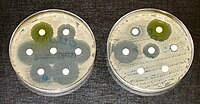
Photo from wikipedia
Aim: This study aims to characterize clinical strains of Acinetobacter baumannii with an extensively drug-resistant phenotype. Methods: VITEK® 2, Etest® method and broth microdilution method for colistin were used. PCR… Click to show full abstract
Aim: This study aims to characterize clinical strains of Acinetobacter baumannii with an extensively drug-resistant phenotype. Methods: VITEK® 2, Etest® method and broth microdilution method for colistin were used. PCR analysis and multilocus sequence typing Pasteur scheme were performed to identify bla-OXA genes and genetic relatedness, respectively. Whole genome sequencing analysis was used to characterize three isolates. Results: All the isolates were susceptible only to polymyxins. blaOXA-23-like gene was the only acquired carbapenemase gene in the 88.2% of the isolates. Multilocus sequence typing identified various sequence types: ST2, ST19, ST195, ST577 and ST632. Two new sequence types, namely, ST1279 and ST1280, were detected by whole genome sequencing. Conclusion: This study showed that carbapenem-resistant A. baumannii isolates causing infections in intensive care units almost exclusively produce OXA-23, underlining their frequent spread in Italy.
Journal Title: Future microbiology
Year Published: 2019
Link to full text (if available)
Share on Social Media: Sign Up to like & get
recommendations!